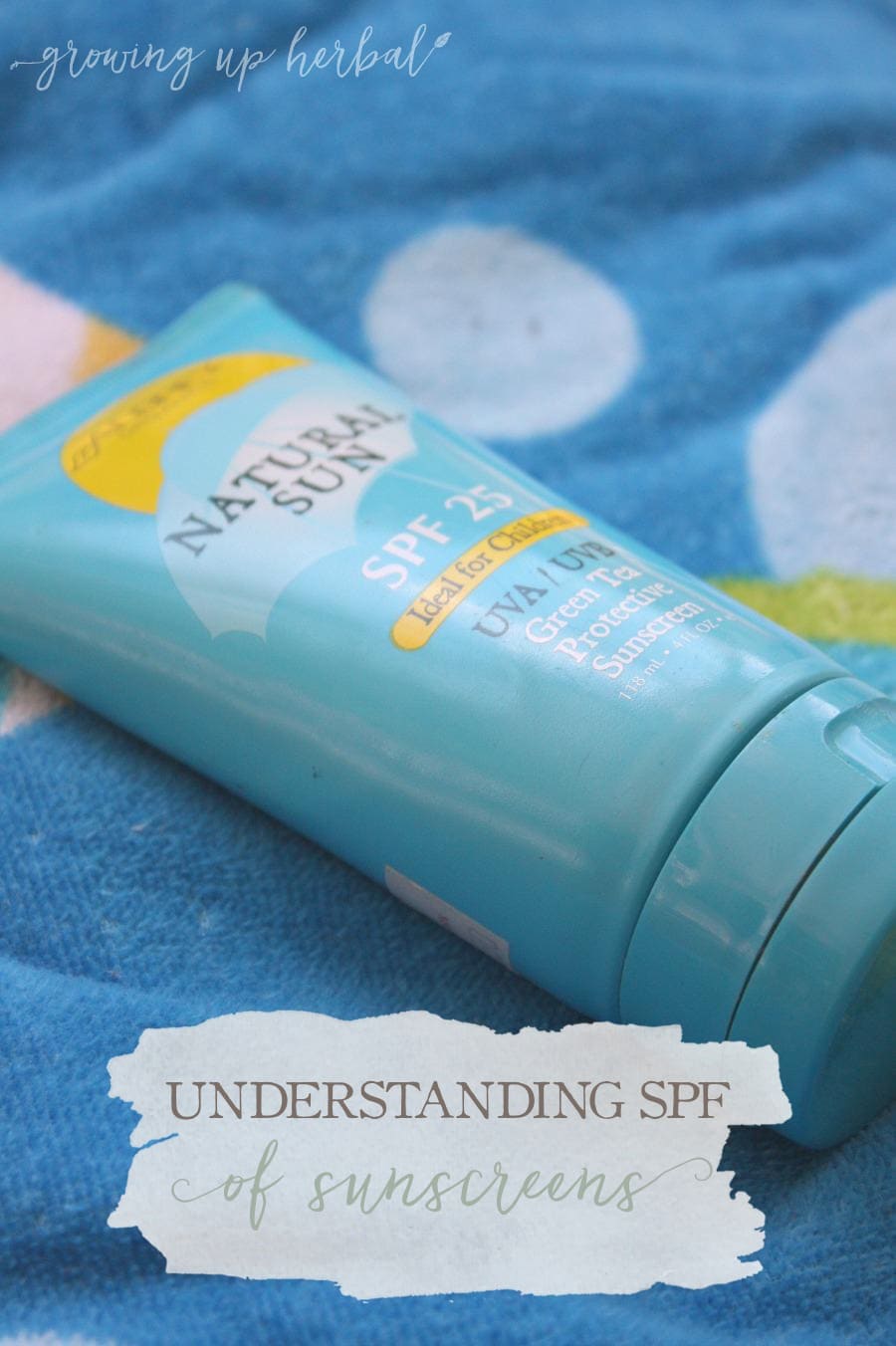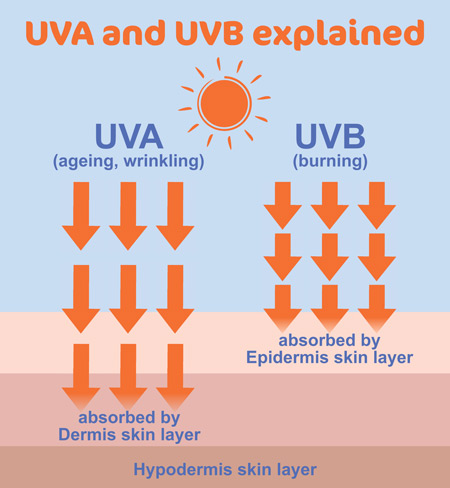
SPF is one of those things that you hear about all the time as summer draws closer, but is it something you understand? Do you know what SPF stands for or what that little rating on the sunscreen bottle actually means?
I’m a big believer in researching things and finding out answers to questions like the ones above.
Why?
Because I want to make an INFORMED decision for myself and my family when it comes to our nutrition and health. I don’t want to take someone else’s word for it unless I trust them and they can show me their tracks. A bottle of cream that claims to have an SPF of 30 and protect the skin from 95% of harmful sun rays doesn’t really inform me on the why or how… it’s just stating a claim.
Well, if you’re like me and want to know the answers to these questions but don’t want to do all the research and digging yourself, keep reading because today, I’m sharing what I’ve learned about SPF. I’ll be sharing what SPF is, what it does, how it works, and what sorts of things are used in sunscreens to give them their SPF rating.
This is interesting stuff!
What Exactly Is SPF?
SPF stands for Sun Protection Factor, and this system was developed by Franz Greiter in 1962. SPF is tested by subjecting humans to noon-like sun exposure – some with sunscreen, some without – and measuring how long it takes for each person to start getting red. These times are then compared, and the sunscreen is given its SPF rating.
This process helps to determine how much protection each SPF gives the skin against UVB rays. At this point in history, this method of determining SPF only works for UVB rays. There is no FDA-approved method from determining SPF protection from UVA rays although this is something that’s being heavily looked into.
Many times you can find sunscreens that claim to be broad-spectrum UV blockers which block UVA and UVB rays. From my understanding, the things that block the UVA rays have nothing to do with the SPF rating but are determined by ingredients used in the sunscreen that cause the UVA rays to be reflected away from the skin. We’ll talk MORE about this later.
What Are UVA, UVB, and UVC Rays?
The sun is a giant ball of energy, and that energy provides humans with light and heat. These waves of light are where ultraviolet rays come from. The majority of the sun’s light rays we can see because they are longer wavelengths, but UVA, UVB, and UVC rays are invisible to the human eye because their wavelengths are shorter.
UVC rays are not known to be a concern because they are so short that they don’t reach the earth, therefore we’re never directly exposed to them.
UVB rays are the next longest, and they’re the rays that only penetrate the top layer of our skin and cause us to burn. They’re stronger during the summer months, but they are around year-round. Have you ever been burned during the winter when there was snow all over the ground? UVB rays can reflect off of water and snow, and these are the rays that are most likely to cause skin cancers.
UVA rays are the longest of these three, and they penetrate the top two layers of our skin and are known for their aging effects. Tanning beds use UVA rays to tan the skin so not only do you get that nice bronze look, over time you also get lots of wrinkles to go along with it.
Understanding SPF Ratings
So when it comes to SPF in sunscreens, what exactly are they protecting from?
Well, it’s these UV rays that your skin is absorbing. You see, the ingredients used to give sunscreens their protective abilities either shield the skin or minimize the UV rays from entering it. The higher the number, the more rays they protect from, and the longer you can stay in the sun without being negatively affected by it.
For example. If you normally start to get red after being in the sun for 10 minutes, and you wear a sunscreen with an SPF of 15, supposedly you can be in the sun for 150 minutes before getting red with the sunscreen on. This estimate isn’t always accurate, though, especially as you reach higher SPF numbers.
Another thing to consider is that most people don’t use enough sunscreen anyway or reapply it often enough. The general rule of thumb is to apply 1 ounce of sunscreen (about a shot glass full) each time you apply it in order to get the full SPF protection the sunscreen is supposed to provide.
Higher SPF Doesn’t Always Equal Better
Now, almost all of my life I’ve thought that the higher the SPF number, the better the sunscreen was for me. Not true! Just because a sunscreen rating is an SPF of 50 doesn’t mean it’s that much better than a sunscreen rating of SPF 30.
Heather from Mommypotomus explains that “huge differences in SPF numbers are actually pretty insignificant when it comes to differences in protection. SPF 100 blocks 99 percent of UVB rays, while SPF 50 blocks 98 percent. SPF 30 blocks 96.7 percent, SPF 15 blocks 93%” in her post on making homemade sunscreen.
Here’s an article from WebMD that also explains how higher SPF’s don’t always mean better and another from the Environmental Working Group about the myth of high SPF sunscreens.
What Gives Sunscreens Their SPF Protection
Many things are used in sunscreens to give them their protective abilities from organic, natural substances to inorganic, synthetic substances. Some are toxic to the skin, and others, not so much.
Sunscreens actually filter the UV rays that get into the skin whereas sunblocks reflect the majority of the rays altogether. Each of these sun protectants requires different ingredients to do their job.
Some of the things that end up in commercial sunscreens that are broad-spectrum sunscreens are things like PABA derivatives, salicylates, and/or cinnamates (octylmethoxycinnamate and cinoxate) for UVB absorption; benzophenones (such as oxybenzone and sulisobenzone) for shorter-wavelength UVA protection; and avobenzone, ecamsule (MexorylTM), titanium dioxide, or zinc oxide for the remaining UVA spectrum.
Yikes! I don’t even know what half of that junk is except for titanium dioxide and zinc oxide, and I don’t think I want that stuff on my skin, especially not my baby’ skin!
My Conclusion
Being protected from harmful sun rays is good and all, but I don’t want to expose myself or my family to all these unnecessary chemical and synthetic ingredients that could be doing more harm than good. Instead, I opt for healthy sun exposure for my family, and I’ll be talking more about that this Wednesday.
Vitamin D is important to me, and the main way we get it is from sun exposure. So most times, we go out in the sun for short bursts of time (20 minutes or so) without any sunscreen on at all. After that, we put on some homemade mineral sunscreen for extra skin protection.
Share this post with your friends on Facebook and Twitter by simply clicking the share buttons below!
REFERENCES:
http://www.sun-protection-and-products-guide.com/SPF.html http://dermatology.about.com/cs/skincareproducts/a/spf.htm http://www.skincancer.org/prevention/uva-and-uvb/understanding-uva-and-uvb http://skincare.about.com/od/sunkissedglow/a/UVAandUVBRays.htm http://chemistry.about.com/od/howthingsworkfaqs/f/sunscreen.htm http://health.howstuffworks.com/skin-care/beauty/sun-care/spf.htm http://www.skincancer.org/prevention/sun-protection/sunscreen/sunscreens-explained https://www.ewg.org/sunscreen/report/whats-wrong-with-high-spf/

I cannot WAIT to hear about your sun cream! My husband is addicted to sunscreen and uses it constantly because as he says, he is ‘afraid of the sun’. I’ve been looking around for a non-toxic version, but can’t find anything I really like. 🙁 He is a red head and burns really easily. Can’t wait to hear about your version!
Oh great Jane! It should be ready and in the shop by next Monday…. fingers crossed! Red heads do tend to burn easier, and I think it’s harder for men to find time to get a little sun here and there during the day until they tan enough to not burn. Some people just don’t tan either. Anyway, it’s totally good for the skin, and I use non-nano zinc in it which reflects the suns rays… not even letting it into the skin. It’s not best if you’re looking to get your daily dose of vitamin D, but it’s great to keep you from getting too red. Thanks for your comment Jane, and great blog BTW!
After SPF 15 it really doesn’t make any difference in protection. I would rather not put all the “extra” stuff on my skin. I know all about dealing with the sun as I am very fair skinned and burn very easily. I do not spend more time then is absolutely necessary out in the sun and when going to the shore I wear a sunhat and long sleeves. The shore is always breezy so in order to enjoy it I do what I must. I look forward to visiting you here on your blog. I found you through Prairie Homestead.
I’m really glad you left a comment Denise! It’s nice to hear what fair-skinned folks do. I agree… SPF doesn’t really improve much after SPF 15… not enough to make a difference anyway, and it sounds like you have a good plan in place for not burning when you are out in the sun for long periods of time. Thanks for your comment, and I’m glad to have you around!
From someone who works in Dermatology….there is not such thing as a “healthy tan”. When your skin has tanned that means the DNA in your cells has been altered by the UVA/UVB rays and overtime this can lead to skin cancers. It is unclear if chemical sunscreens cause cancer but we do now the sun does. The suns rays are carcinogenic and skin cancer is the most common type of cancer in the world. As for vitamin D, why risk getting it from the sun if you can eat it? Fish, such as herring have more than your daily value of vitamin D and it is not as risky as tanning. Hats and clothing are the best protection from the sun and zinc oxide and titanium dioxide are the best choices for sunscreen. I would encourage you to educate yourself about skin cancer….
Feel free to read this post – Is There Such A Thing As A “Healthy Tan” – that I wrote after doing more research on safe sun exposure. Oh, and this is the recipe for my favorite mineral sunscreen too, in case you’re interested.